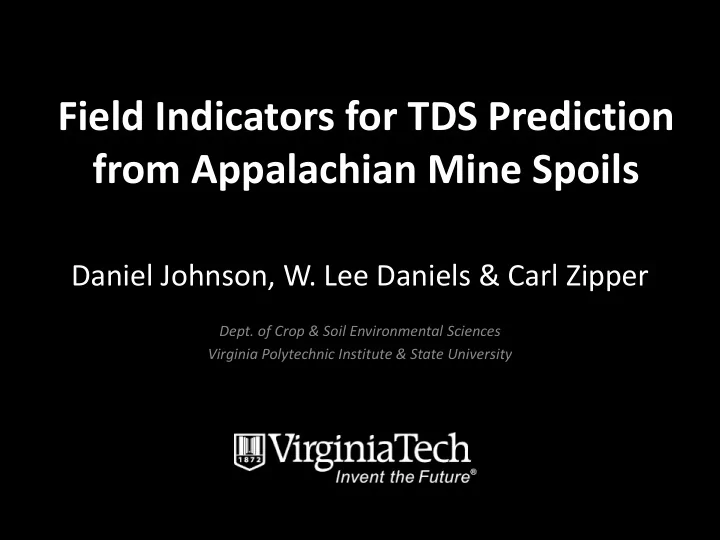

Field Indicators for TDS Prediction from Appalachian Mine Spoils Daniel Johnson, W. Lee Daniels & Carl Zipper Dept. of Crop & Soil Environmental Sciences Virginia Polytechnic Institute & State University
TDS Risk: ? ? ? ? ?
Objectives: Measure the net TDS elution potential of a range of materials originating from surface coal mines in Central Appalachia and analyze the following geochemical properties: − Saturated paste SC, pH, and ionic composition − Microwave assisted acid digestion and total sulfur (total-S) − Citrate-dithionite (CD) - extractable Al, Fe, and Mn − Hydrogen peroxide (H 2 O 2 ) pH and SC Investigate the nature of the boundary between weathered and unweathered strata to determine if: − An abrupt boundary exists at some confining layer, such as a shale or mudstone layer; or − The boundary is more diffuse, being more related to the distance from the earth’s surface.
Objectives: Develop a set of simple field indicators for predicting TDS elution potential by statistically relating the geochemical properties described above to the following properties: − Munsell color, hue, value, and chroma − Rock type − Horizon Type − Degree of preweathering − Hydrochloric (HCl) acid fizz test − H 2 O 2 reaction
Sampling and Replication Scheme : 02-c-01 02-a-01 02-c-02 02-b-01 02-a-02 02-c-03 02-b-02 02-a-03 02-b-03 02-a-04 02-c-04 02-a-05 02-c-05 02-b-04 02-c-06 02-a-06 02-b-05 02-c-07 02-a-07 02-b-06 02-c-08 02-a-08 02-b-07 Each distinct layer was sampled and described according to the NRCS Field Book for Describing and Sampling Soils, version 3.0
Saturated Paste Specific Conductance Across all Sites
Saturated Paste Major Ions n = 120 n = 52 n = 32
Saturated Paste Minor Ions n = 120 n = 52 n = 32
Microwave Assisted Acid Digest Major Ions n = 120 n = 52 n = 32
n = 120 n = 52 n = 32
Sandstones – Thin Section Analysis generally quartz rich subarkoses or sublitharenites high in weatherable feldspars
TDS Production Risk
A B Weathered R Unweathered R C
Reaction with 30% H 2 O 2
Summary SC had a very strong direct and linear relationship with the sum of all of the ions study… ~1:1 ratio Sulfate-S, Ca, and Mg dominated saturated paste SC for the samples studied Many other ions present in lower concentrations did not increase from low to high TDS samples (Se DID increase from low to high TDS)significantly Shallowest shale/mudstone layer forms boundary between weathered/unweathered spoils Unweathered samples lower in SC, Ca, Mg, and sulfate-S SC, sulfate-S, Ca, Mg, Se all higher in heat/violent H2O2 reaction samples Low TDS Risk High TDS Risk Dark gray, very dark gray, black Yellowish-brown Shale, mudstone, coal Soil, sandstone Heat or violent H 2 O 2 reaction Cold H 2 O 2 reaction High Se Low Se Unweathered – below SH/MS layer Weathered – above SH/MS layer
Recommendations Figure by Daniel K. Johnson
Recommendations Figure and concept by Dr. Carl Zipper
Acknowledgements Funding: Powell River Project Site Access: Teco Coal, Red River Coal Company, Apogee Coal Company, Alpha Natural Resources, and others Field and lab assistance: Staff and students of the Virginia Tech marginal soils research group Special Thanks: Dr. Lee Daniels, Dr. John Galbraith, Dr. Carl Zipper, Dr. Ken Eriksson, and Dr. Stephen Schoenholtz
Recommend
More recommend